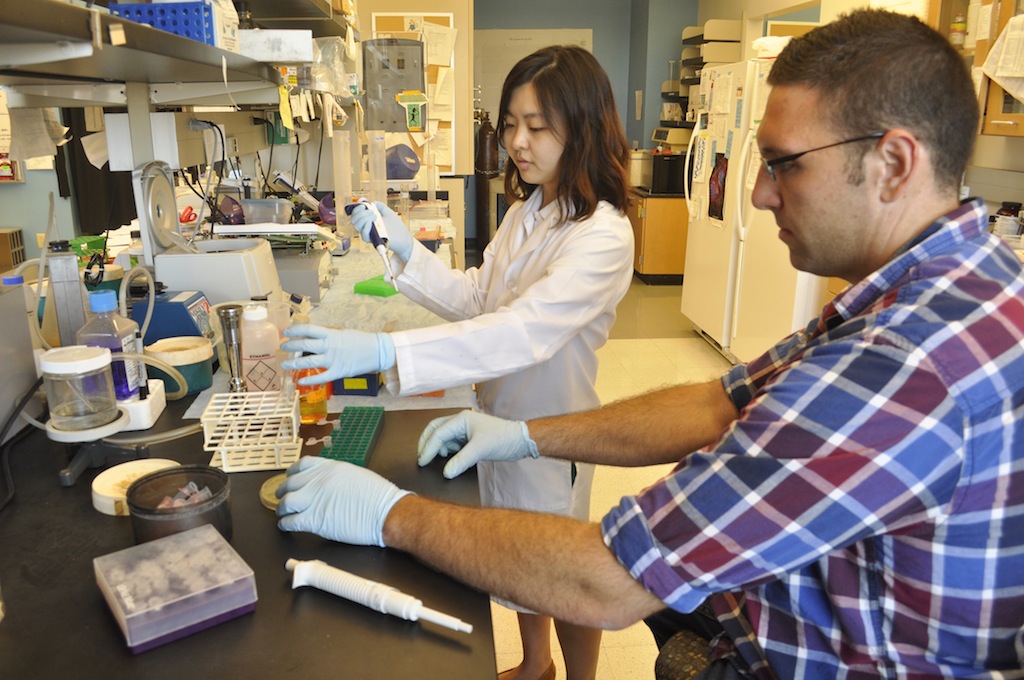
By Madison Knapp | Bond Life Sciences Center summer intern
Modern science has found a way to turn viruses —tiny, dangerous weapons responsible for runny noses, crippling stomach pains and worldwide epidemics such as AIDS— into a tool.
Gene therapy centers on the idea that scientists can hijack viruses and use them as vehicles to deliver DNA to organs in the body that are missing important genes, but the understanding of virus behavior is far from exhaustive.
Marc Johnson, researcher at the Christopher S. Bond Life Sciences Center and associate professor of molecular microbiology and immunology in the MU School of Medicine, has been building an understanding of viral navigation mechanisms which allow a virus to recognize the kind of cell it can infect.
Johnson’s research specifically explores the intricacies of the viral navigation system and could improve future direction of gene therapy, he said.

Turning a virus into a tool
Conceptualized in the 1970s, gene therapy was developed to treat patients for a variety of diseases, including Parkinson’s, leukemia and hemophilia (a genetic condition that stops blood from clotting).
To treat disease using gene therapy, a customized virus is prepared. A virus can be thought of as a missile with a navigation system and two other basic subunits: A capsule that holds the ammunition and the ammunition itself.
The viral genetic material can be thought of as the missile’s ammunition. When a cell is infected, this genetic material is deployed and incorporated into the cell’s DNA. The host cell then becomes a factory producing parts of the virus. Those parts assemble inside the cell to make a new virus, which then leaves the cell to infect another.
The capsule is made of structural protein that contains the genetic material, and the navigation system is a protein that allows the virus to recognize the kind of cell it can infect.
Viral navigation
Gene therapy uses viruses to solve many problems by utilizing a virus’ ability to integrate itself into a host cell’s DNA; to do this successfully, researchers need to provide a compatible navigation component.
In the body, viruses speed around as if on a busy highway. Each virus has a navigation system telling it which cells to infect. But sometimes if a virus picks up the wrong type of navigation system, it doesn’t know where to go at all.
“What you can do is find a virus that infects the liver already, steal its navigation protein and use that to assemble the virus you want to deliver the gene the liver needs,” Johnson said. “You can basically take the guidance system off of one and stick it onto another to custom design your virus.”
But this doesn’t always work because of incompatibility among certain viruses, he said.
Johnson and his lab are working to understand what makes switching out navigation proteins possible and why some viruses’ navigation systems are incompatible with other viruses.
“I’m trying to understand what makes it compatible so that hopefully down the road we can intelligently make others compatible,” Johnson said.
The right map, the right destination
Johnson creates custom viruses by introducing the three viral components—structural protein, genetic material, and navigation protein—to a cell culture. The structural protein and genetic material match, but the navigation component is the wild card. It could either take to the other parts to produce an infectious virus, or it could be incompatible.
Johnson uses a special fluorescent microscope to identify which viruses assembled correctly and which didn’t.
A successful pairing is like making a match. If a navigation protein is programmed to target liver cells, it’s considered a successful pairing when the virus arrives at the liver cell target location.
The scope of gene therapy continues to widen. Improved mechanisms for gene therapy, and greater knowledge of how a navigation protein drives a virus could help more people benefit from the vehicles viruses can become.
Johnson uses several high-profile model retroviruses, including human immunodeficiency virus (HIV), which affects an estimated 35 million people worldwide each year, according to the World Health Organization.
Understanding nuances of HIV in comparison to other viruses allows Johnson to pick out which behaviors might be common to all retroviruses and others behaviors that might be specific to each virus.
Johnson said his more general approach makes it easier to understand more complex viral features.
“If there are multiple mechanisms at work, it gets a little trickier,” Johnson said. “My angle is more generic, which makes it easier to tease them apart.”
Supervising editor is Paige Blankenbuehler

